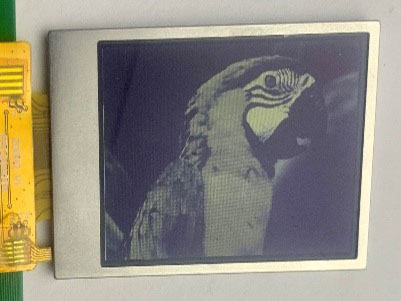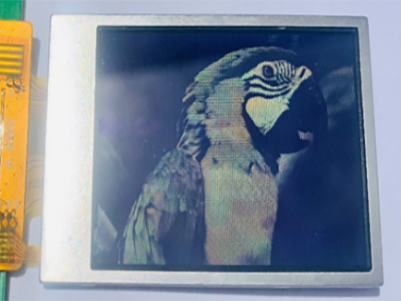Transflective TFT’s for Battery Conservation
In this application note we will discuss how battery power can be conserved when using a transflective display in direct sunlight. Transflective displays are a great option for applications that have access to bright ambient lighting. In these environments transflective displays can turn off the backlight LED’s and use the bright lighting to illuminate the display. This is a great way to save power as backlights can be the most significant energy drain on a display.
Reflective + Transmissive = Transflective
1. Introduction
In this example, we will be using a 240×320 transflective TFT display and a STM-Nucleo microcontroller to feature the applications of the E20RB-FW345-N display module. As for any display, be sure the check the data sheet to determine the pin out, voltage ratings and driver of the module. Below is an overview of the display used in this project (datasheet). An overview of the significant features of this display are as follows:
- 2-inch, 35.80 x 52.10mm
- 240×320 pixels
- VA Transflective
- ST7789V Controller IC
- White LED backlight, 4 LEDs
- 65k/262k colors
- Parallel and Serial interfaces
- 345 NITS

2. Pin Assignments
Pin definitions and connection points are described in the table below. We will use the 4-wire serial interface for this example to save data pins on the microcontroller. There are established 4-wire SPI pins labelled on the microcontroller. Any alternative pins used must be declared in code when programming the device. A more in-depth description of each of the pins can be found on the datasheet. All unused pins are connected to ground.

The backlight LED’s are connected to an external battery and are separate from the 3.3V logic voltage. The voltage that is applied to the backlight LEDs can be adjusted through variable resistors, such as a potentiometer or through programming if connected to an additional PWM pin on the microcontroller.
3. Example Lighting Environments
The forward voltage of the backlight LEDs has a typical value of 3.2-3.3V and the current can be adjusted to increase or decrease the backlight of the display.

This example will demonstrate the power consumption of the 4 backlight LEDs at different lighting levels. In an outdoor application the backlight could be turned off and in indoor applications the backlight can be turned off. Below are various lighting conditions and their corresponding backlight power. The table also specifies which aspect of the transflective TFT is dominant, transmissive or reflective.
| No. | Ambient Condition | Backlight Power | Transmissive or Reflective | Example |
|---|---|---|---|---|
| 1 | Bright Indoor Lighting | 100% | Transmissive |  |
| 2 | 0% | Reflective |  | |
| 3 | Dark Environment | 100% | Transmissive |  |
| 4 | Full Sunlight | 100% | Transmissive & Reflective |  |
| 5 | 0% | Reflective |  |
At full backlight power in a dark room the display will appear more vibrant and colorful. This is making use of the fully transmissive mode of the transflective display. In very bright sunlight the transflective display will reflect the sunlight to illuminate the image. It can be seen in both images of the transflective display in full sunlight that the backlight makes little difference as the display will always reflect the bright sunlight.


The reflective and transmissive properties are inherent to the transflective display. These modes specify the type of polarizer within the display and therefore they cannot be “turned on” or “turned off”. The transflective display will use the reflective mode when in very bright light while in darker environments the transmissive mode will be used.
4. Energy Efficiency
Backlights are often the biggest power drain for a display. By turning off the backlight in outdoor environments energy can be conserved. This example is using a 2-inch display with 4 backlight LEDs which require 3.3V and 80mA of current to illuminate the display in the transmissive mode. The power cost from the backlight becomes substantial in larger displays and TFT’s that have brighter LEDs to compensate for bright environments.
Below is a table comparing the power consumption of different sizes of transflective TFT’s. For battery powered devices the battery is typically measured in milli-Watt hours (mWh) and milli-Amp hours (mAh). For reference, one AA battery at 1.5V provides 200-400 milli-Watt hours.
| Display | Size (inch) | Brightness (Nits) | # of LEDs | Voltage (V) | Current (mAh) | Watts (mWh) | Power (kJ) |
|---|---|---|---|---|---|---|---|
| E20RB-FW345-N | 2.0″ | 345 | 4 | 3.0 | 80 | 240 | 0.95 |
| E24RB-FW360-N | 2.4″ | 360 | 6 | 19.2 | 20 | 384 | 1.39 |
| E35RC-FW115-N | 3.5″ | 115 | 6 | 18.6 | 20 | 372 | 1.34 |
5. Summary
Transflective TFT’s are a great option for applications that have bright ambient lighting available. Reflecting the ambient lighting to illuminate the display has the added benefit of conserving power. Backlights can have a wide range of power consumptions and typical increase with the size of the display. A non-transflective TFT would be washed out by bright lighting and have limited visibility. An alternative solution for bright environments is to opt for a sunlight readable TFT. These displays increase the backlight to high levels to compensate for the bright lighting. This comes at the cost of high-power demand on the backlight thus decreasing energy efficiency. For more on sunlight readable TFT’s and how they compare to transflective TFT’s visit FocusLCDs.com.
DISCLAIMER
Buyers and others who are developing systems that incorporate FocusLCDs products (collectively, “Designers”) understand and agree that Designers remain responsible for using their independent analysis, evaluation and judgment in designing their applications and that Designers have full and exclusive responsibility to assure the safety of Designers’ applications and compliance of their applications (and of all FocusLCDs products used in or for Designers’ applications) with all applicable regulations, laws and other applicable requirements.
Designer represents that, with respect to their applications, Designer has all the necessary expertise to create and implement safeguards that:
(1) anticipate dangerous consequences of failures
(2) monitor failures and their consequences, and
(3) lessen the likelihood of failures that might cause harm and take appropriate actions.
Designer agrees that prior to using or distributing any applications that include FocusLCDs products, Designer will thoroughly test such applications and the functionality of such FocusLCDs products as used in such applications.